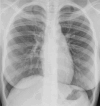Microcardia and cardiomegaly screening using postero-anterior chest X-ray (PA CXR) across university students in Ghana - a retrospective study
- PMID: 39731021
- PMCID: PMC11673647
- DOI: 10.1186/s12880-024-01532-w
Microcardia and cardiomegaly screening using postero-anterior chest X-ray (PA CXR) across university students in Ghana - a retrospective study
Abstract
Background: Microcardia and cardiomegaly are good diagnostic and prognostic tools for several diseases. This study investigated the distribution of microcardia and cardiomegaly among students of the University of Health and Allied Sciences (UHAS) in Ghana to determine the prevalence of microcardia and cardiomegaly across gender, and to evaluate the correlation between the presence of these heart conditions and age.
Methods: This retrospective study involved a review of 4519 postero-anterior (PA) chest X-rays (CXRs) between 2020 and 2023. The CXRs were taken using a digital radiography machine. The CXRs were obtained on PA projection, with the students upright, on arrested inspiration and a source-to-detector distance of 180 cm. Only CXR images with no significant rotation (assessed using the distance between the medial ends of the clavicles and the vertebral spinous processes) and lung abnormalities were included in the study. The transverse cardiac diameter (TCD) and transverse thoracic diameter (TTD) were measured and cardiothoracic ratio (CTR) calculated for each CXR. The CTR was calculated as a ratio of TCD/TTD and categorised as microcardia (CTR < 0.42), normal heart size (0.42 < CTR ≤ 0.50) and cardiomegaly (0.50 < CTR ≤ 0.60). The data was analysed using the Statistical Package for the Social Sciences (SPSS) version 26 and descriptive and inferential statistics were conducted. The Mann-Whitney U Test was conducted to determine statistically significant differences in TCD, TTD and CTR across female and male students. Spearman's rho correlation was conducted to investigate the relationships between age and TCD, TTD and CTR.
Results: The students were aged 15-37 years (mean = 19.60 ± 2.20) with a modal age of 18 years. The study included 2930 (64.84%) females and 1589 (35.16%) males. Most of the students [3384 (74.88%)] had normal heart sizes. However, 647 (14.32%) had microcardia whereas 488 (10.80%) had cardiomegaly. Out of the students suffering from cardiomegaly, 478 (97.95%) and 10 (2.05%) had mild/moderate and severe cardiomegaly respectively. Cardiomegaly was more common among the female students (p < 0.05) and those aged 15-22 years [418 (85.66%)]. There was no correlation between TCD, TTD and CTR and age [ r = 0.01, p = 0.42; r = 0.02, p = 0.17; r = 0.01, p = 0.66, respectively].
Conclusion: The majority of the students had normal heart sizes, but a few had microcardia and cardiomegaly. Cardiomegaly was more common among the female students. The presence of microcardia and cardiomegaly could have health implications for the students and increase their risks of cardiovascular diseases hence these students should be further screened medically for the underlying causes though they may be asymptomatic. Stakeholders in higher education and public health may find this study useful in developing strategies to minimise the prevalence of cardiac diseases and also improve treatment.
Keywords: Cardiomegaly; Cardiovascular diseases; Chest X-ray; Ghana; Microcardia; Students; University.
© 2024. The Author(s).
Conflict of interest statement
Declarations. Ethics approval and consent to participate: Ethical approval for this study was granted by the Research Ethics Committee (REC) of UHAS prior to accessing the data [A.8(114) 22–23]. Informed consent was also obtained from the students. Also, because the age of adulthood in Ghana is 18 years, informed consent was obtained from guardians of the students less than 18 years of age involved in the study. To ensure confidentiality, the CXRs were made available only to the researchers and each CXR was coded and personal identifying information removed to ensure anonymity. The study conformed with the Declaration of Helsinki. Consent for publication: Not applicable. Competing interests: The authors declare no competing interests.
Figures




Similar articles
-
Radiographic determination of cardiomegaly using cardiothoracic ratio and transverse cardiac diameter: can one size fit all? Part one.Pan Afr Med J. 2017 Jul 14;27:201. doi: 10.11604/pamj.2017.27.201.12017. eCollection 2017. Pan Afr Med J. 2017. PMID: 28904726 Free PMC article.
-
Two-dimensional cardiothoracic ratio for evaluation of cardiac size in German shepherd dogs.J Vet Cardiol. 2014 Dec;16(4):237-44. doi: 10.1016/j.jvc.2014.08.001. Epub 2014 Sep 18. J Vet Cardiol. 2014. PMID: 25438928
-
Gender and Age Differences in Cardiac Size Parameters of Ghanaian Adults: Can One Parameter Fit All? Part Two.Ethiop J Health Sci. 2021 May;31(3):561-572. doi: 10.4314/ejhs.v31i3.13. Ethiop J Health Sci. 2021. PMID: 34483613 Free PMC article.
-
Measurement of Cardiothoracic Ratio on Chest X-rays Using Artificial Intelligence-A Systematic Review and Meta-Analysis.J Clin Med. 2024 Aug 8;13(16):4659. doi: 10.3390/jcm13164659. J Clin Med. 2024. PMID: 39200806 Free PMC article. Review.
-
A review on lung boundary detection in chest X-rays.Int J Comput Assist Radiol Surg. 2019 Apr;14(4):563-576. doi: 10.1007/s11548-019-01917-1. Epub 2019 Feb 7. Int J Comput Assist Radiol Surg. 2019. PMID: 30730032 Free PMC article. Review.
References
MeSH terms
LinkOut - more resources
Full Text Sources
Research Materials

